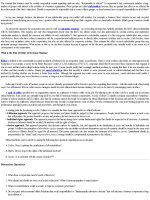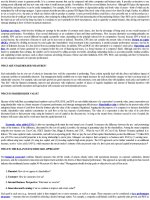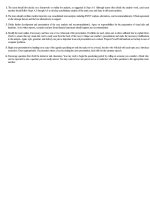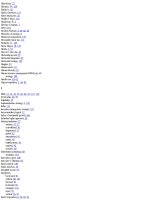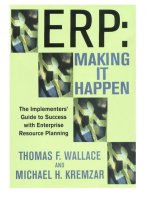Slide of strategic management w5
Bạn đang xem bản rút gọn của tài liệu. Xem và tải ngay bản đầy đủ của tài liệu tại đây (357.31 KB, 30 trang )
Bma799
Strategic management
Lecture Five:
Resources and Capabilities
Learning Objectives
•
•
•
•
•
Explain the nature of ‘competitive advantage’
Discuss the concept of the value chain and its links to competitive advantage
Describe the role of an organisation's resources
and capabilities as a basis of competitive advantage
Identify the resources and capabilities of an organisation
Evaluate the potential for an organisation's resources and capabilities to sustain competitive
advantage
The Nature of Competitive Advantage
• Competitive advantage is a characteristic, feature or opportunity that an organisation
•
possesses that will make it more attractive than its competitors
For any company, the creation and sustainability of competitive advantage is a main
consideration when they formulate their strategy.
• Competitive advantage is displayed by superior performance and value created for
the organisation’s customers
The Nature of Competitive Advantage
• The notion of value is central to competitive advantage of any organisation
• Value creation is defined in many different ways
• Value refers to a product’s performance characteristics and attributes for which
customers are willing to pay
The Nature of Competitive Advantage
• The ability of organisations to develop a competitive advantage depends on their
•
ability to position their business system in the business environment
Business system comprises resources (inputs), activities (throughputs) and product/service
offerings (outputs) intended to create value for customers
Product/Service Offerings
• To achieve an attractive fit with customers’ needs an organisation must know its
•
•
•
target segment of the market.
The decision regarding the target customer is an important one.
Organisations divide customers into groups according to the differences in customers’
needs.
This is referred to as market segmentation.
Product/Service Offerings
• Market segments can be defined on the basis of buying criteria employed and/or
•
•
buyer behaviour exhibited.
Market segmentation should allow an organisation’s strategists to gather a better
insight into customers and lead to new opportunities for developing product/service
offerings that are tailored to the needs of target customers.
Competitive advantage can be achieved only if a company is able to satisfy its
chosen market segment.
Product/Service Offerings
• Positioning is achieved by alignment of the three elements of the business system:
•
•
product/service offering, value chain and the resources base.
Positioning is concerned with the decisions ‘where to compete’ and ‘how to compete.’
The choice of certain product/market combinations in which a company wants to
participate is referred to as the choice of competitive scope
Value Chain Analysis
• Value chain analysis enables organisations to understand which activities create
value and which do not.
• The value chain is a template used by an organisation to identify its cost position, and
the means that might be used to facilitate implementation of a chosen business level
strategy.
• A competitive advantage can be created if the company’s value chain creates
additional value without incurring significant extra costs
Resource-Based View
The resource-based model assumes that:
•
Each organisation is a collection of unique resources and capabilities that provides the
basis for its strategy and is the primary source of returns
•
Differences in firms’ performance are due primarily to their unique resources and
capabilities rather than structural characteristics of the industry.
• The central question of the RBV is ‘why do some companies in the same industry
outperform others?’
Resource-Based View (Cont.)
•
The resource based model proposes that:
•
•
•
Resources are inputs into a firm’s production process
A capability is the capacity for set of resources to perform a task
Capabilities evolve and must be managed dynamically.
Resource-Based Model (Cont.)
Components of Internal Analysis
Role of Resources and Capabilities
Fig. 5.2
The Resources of the Company
Fig. 5.5
The Resources of the Company
• Resources and capabilities of an organisation are two different and distinct categories
• Resources are the productive assets owned by an organisation
• The three principle types of resources:
―tangible
―intangible
―human
Organisational Capabilities
• Resources are not productive on their own
• To perform a task, a team of resources must work together
• Organisational capability refers to an organisation’s capacity to deploy resources
for a desired result
Classifying capabilities
• Two approaches for classifying capabilities are:
• A functional analysis identifies organisational capabilities in relation to each of the principal
functional areas of the company
• A value chain analysis separates the activities of the company into a sequential chain
Value Chain Analysis
Fig. 5.1
Primary Activities
• Primary activities are actions directly associated with production, delivery, sales and service.
The key activities include:
• Inbound logistics,
• Operations,
• Outbound logistics,
• Marketing and sales, and
• Service
Support Activities
• Support activities are actions that enable primary activities to take place, including:
• Human resource management,
• Procurement,
• Technology development and
• Organisational infrastructure
Competencies and Capabilities
• Competence is the product of learning and experience that represents real proficiency in
•
•
performing an internal activity
Organisations deliberately develop their competencies over time by making efforts to do
something
Competencies represent the combination of skills, resources and technologies, as opposed to
a single specific skill or resource
Competencies and Capabilities
• In general, every organisation has a collection of capabilities, some of them
stronger and more competitive than the others
• Competitive capability is a competence that is appreciated by customers and
distinguishes the organisation from its rivals
Competencies and Capabilities
• Core competencies are activities that an organisation performs better than its other internal
•
activities and that are the most critical to competitiveness and profitability
Core competencies may reside, for example, in the company’s people, technology, ability to
build networks and systems which enable electronic commerce, or skills in manufacturing
innovative products.
Competencies and Capabilities
• Distinctive competence refers to an activity an organisation does well relative to
its rivals
• Generally, a core competence becomes a basis for competitive advantage
only when it is a distinctive competence
